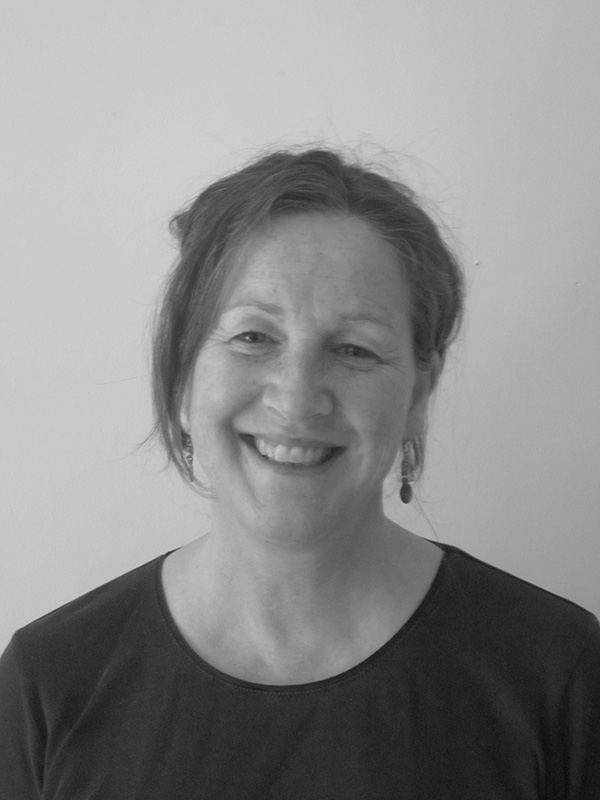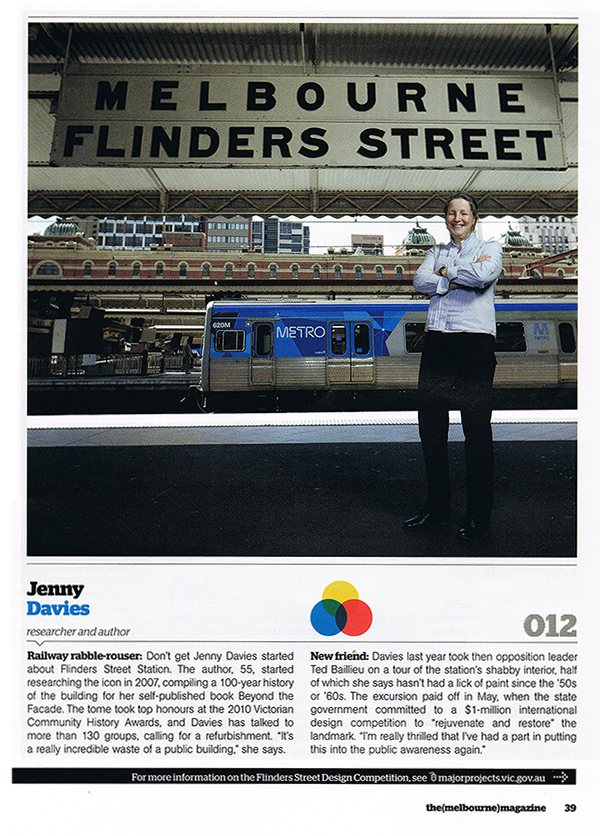CONTACT
Jenny Davies, the driving force and inspiration for the Flinders Street Station Project sadly passed away in June of 2024. |
The connection Melburnians and Victorians have to the Station provided a great sense of mission in Jenny's life. |
In loving memory of their mother, the below extract comes from Jenny’s eulogy delivered by her children Bryn and Meredith Davies, and relates to her commitment to what would become the Flinders Street Station Project. |
Should you wish to connect to the Flinders Street Station Project, you can via the below email.
|

Honouring Jenny Davies - Beyond the façade; beyond a book
In 2009 mum released her book Beyond the façade: Flinders Street, more than just a railway station.
Incredibly, she had only contemplated writing the book less than 2-years earlier, when she started with a simple line of inquiry.
She was aware that her mother and father had been to an event at Flinders Street early in their courtship, perhaps a dance in the famous ballroom. She wanted to know more about the building’s history to better understand the role it had played in her parents' lives.
Much to her amazement, she found almost no detailed or documented history on Flinders Street station, despite it being arguably Melbourne’s and Victoria's most iconic and culturally connected building.
Not content with that answer, she decided then and there to research and write its history herself, not just of the building, but significantly, its social history.
She was driven to uncover the stories, the people and the connection they had to place that made this building so much more than a railway station.
Motivated by a deep faith that this was part of her purpose in life, she relentlessly went about her rigorous research.

She searched library and archive databases from across the world, she found original building drawings, old pictures and hand-written letters long thought lost in garages across the country, and perhaps most time sensitively, she interviewed people, many of them in then already in their 90s, who had worked, studied, trained or attended functions at the station in its heyday.
These included now older men who as kids had sold newspapers on the steps 'under the clocks' through the era of Rockers and Mods in the 1960s, and now very old women who had been taught ballet in the famous ballroom in the 1930s.
Before it was too late, mum capture history firsthand from those who were there and combine it with almost a century's worth of newspaper articles, letters, government reports and budget papers.
She wove all of these into a rich and captivating story, understanding the essence of why Flinders Street was so important in housing and defining the culture of a city and its people.
Did I mention she researched, wrote, designed, and self-published all of that within 2-years?
Perhaps what makes that even more remarkable, was that from the very beginning, for mum it was never really just about writing a book.
The station was built in 1910, so 2010 was to mark its centenary anniversary. Mum was adamant that the book needed to be finished before this anniversary to put pressure on the government to restore this treasured cultural asset.
So, in parallel to writing a book, mum was running a campaign.
Following the book’s release, she travelled Victoria presenting to historical societies, Probus and Rotary groups on a weekly basis. Her presentations always dedicating time at the end to the campaign – leaving her audiences with no doubt that Flinders Street Station was all of ours and must be restored for the public to use.
This groundswell of community activation translated into the political world, and in 2012 she showed then opposition leader and trained architect Ted Baillieu around the decaying floors of the station.
After climbing up the Elizabeth Street clocktower stairs Ted would turn to mum and proclaim that if he won government, he would hold a design competition to develop options for the station's renewal.
He did win government, and he did hold a $1 million competition, with renowned architects from across Australia and the around world submitting designs.
None of the proposed designs were progressed, but the competition brought to the public's attention the terrible state the station was in and the opportunity its restoration presented.
In 2015 the Andrew’s government committed $100 million to the station’s restoration – not so much with a grand vision for its future, but to undertake essential works that would stop it falling down and to re-paint the exterior to match its original colour scheme.
Mum supported the heritage architects colour match paints from historical records, find unique pressed metal patterns long-lost, and assisted in determining what was proper old versus just 1980s old.
When restoration works were completed in 2018, the RISING festival team negotiated an agreement to use the restored floors and the famous ballroom for the first time in over 40 years.
Globally renowned local artist Patricia Piccinni was selected to develop works for the spaces, with mum and Patricia hosting tours together when the exhibition opened in 2021.
While nice to share the spotlight with a world-famous artist, for mum the most important thing was that the station was again open to the people, with over 80,000 flowing through the doors for that exhibition.
Her vision to return the building to public use had been realised.
By the end she had sold over 4,000 copies of her self-published book, serendipitously mailing out the last of her copies in May of this year.
She'd spoken with over 250 groups, woken up for dozens of early morning radio interviews, and hosted countless tours of the station with politicians and interested members of the public.
Beyond the façade – the book and the movement for change – combined mum's passion and commitment with her remarkable diversity of skills and talents, providing an inspiration for us all.
For her contributions to history she won several awards, including the overall winner of the 2010 Victorian History Award.
But one of her, and our proudest moments was when she won the 2010 Melbourne Award individual division, not solely for her contribution to history, but for her contribution to the city’s identity.
This recognised that in documenting and celebrating our past, she hadn’t just captured history, she’d managed to change the future.

